Похожие презентации:
Financial reporting
1.
Financial reportingBy: Yurasova Irina Olegovna,
Associate Professor,
Department of Audit & Corporate Reporting
iyurasova@fa.ru
2.
Assessment schemeMarks
attendance:
-lectures
2
-classes
class work
4
6
10
HCT
Questionnaries, HT, cases,
tests, team work
science
Total
Credit (MCQs+statements)
18
in addition
40
60
3.
ReferencesFinancial Reporting (FR) ACCA
www.ifrs.org
Международные стандарты
финансовой отчетности :
учебник / под ред. В.Г. Гетьмана.
— 4-е изд., перераб. и доп. — М. :
ИНФРА-М, 2022. — 582 с.
4.
Conceptual frameworkis a statement of generally accepted
theoretical principles which form the
frame of reference for financial
reporting
5.
Conceptual framework andGAAP
Conceptual framework will form the
theoretical basis
Danger of not having a conceptual
framework:
contradictions and inconsistencies in
basic concepts
highly detailed standards
political pressure
6.
Advantages of a conceptualframework
standardising accounting practice
lower political interference
concentration on the same aspects
7.
Disadvantages of a conceptualframework
not certain that a single conceptual
framework can be devised which will
suit all users
may be a need for a variety of
accounting standards
not clear that a conceptual framework
makes the task of preparing and then
implementing standards any easier than
without a framework
8.
Sources of RegulationCompany Law
Accounting Standards
*Listing Rules
9.
GAAPInternational
National
IAS
UK GAAP
IFRS
US GAAP
10.
The objective of generalpurpose financial reporting
to provide information about the
reporting entity that is useful to existing
and potential investors, lenders and
other creditors in making decisions
about providing resources to the entity
11.
Types of economic decisionsBuying, selling or holding equity and
debt instruments;
Providing or settling loans and other
forms of credit; or
Exercising rights to vote on, or
otherwise influence, management's
actions that affect the use of the
entity's economic resources
12.
Review of the stewardshipto be able to review the financial
performance of the entity (effectively,
the income and expenses) as well as
other transactions (such as issuing
debt, the capital maintenance and
equity of the entity)
13.
Scope of the ConceptualFramework:
Chapter 1 The objective of general purpose financial reporting
Chapter 2 Qualitative characteristics of useful financial information
Chapter 3 Financial statements and the reporting entity
Chapter 4 The elements of financial statements
Chapter 5 Recognition and derecognition
Chapter 6 Measurement
Chapter 7 Presentation and disclosure
Chapter 8 Concepts of capital and capital maintenance
14.
Accrual accountingThe effects of transactions and other
events and circumstances on a
reporting entity's economic resources
and claims are recognised in the
periods in which they occur , even if the
resulting cash receipts and payments
occur in a different period
15.
The qualitative characteristicsidentify the types of information that are likely to
be most useful to the existing and potential
investors, lenders and other creditors for making
decisions about the reporting entity on the basis
of information in its financial report (financial
information).
16.
Qualitative characteristics of financial statementsRelevance
Materiality
complete
neutral
free
from
error
Faithful
representation
17.
RelevanceRelevant financial information is capable of making a difference in the decisions
made by users.
Information may be capable of making a difference in a decision even if some
users choose not to take advantage of it or are already aware of it from
other sources.
Predictive value
Confirmatory
value
17
18.
Faithful representationfinancial information must faithfully represent the
phenomena that it purports to represent
19.
completeA complete depiction includes all information necessary
for a user to understand the phenomenon being
depicted, including all necessary descriptions and
explanations
19
20.
neutralA neutral depiction is without bias in the selection or
presentation of financial information
20
21.
freefrom
error
there are no errors or omissions in the description of the
phenomenon, and the process used to produce the
reported information has been selected and applied
with no errors in the process
21
22.
Enhancing qualitative characteristics of financial statementsComparability
Verifiability
Timeliness
Understandability
23.
Comparabilityenables users to identify and understand similarities in,
and differences among, items
Consistency
disclosure of
accounting
policies
changes in an
accounting policy
Corresponding
information
not the same as
uniformity
23
24.
Verifiabilitydifferent knowledgeable and independent observers
could reach consensus, although not necessarily
complete agreement, that a particular depiction is a
faithful representation
24
25.
Timelinesshaving information available to decision-makers in time
to be capable of influencing their decisions
25
26.
UnderstandabilityClassifying, characterising and presenting information
clearly and concisely makes it understandable
Financial reports are prepared for users who have a
reasonable knowledge of business and economic
activities and who review and analyse the information
diligently
26
27.
The cost constraint onuseful financial reporting
Benefits must exceed the costs
Providers of financial information - collecting,
processing, verifying and disseminating financial
information
Users of financial information - analysing and
interpreting the information provided
subjective area
28.
Underlying assumptionThe financial statements are normally prepared
on the assumption that an entity is a going
concern and will continue in operation for the
foreseeable future.
29.
The elements of financialstatements
Assets
financial
position
Equity
Liabilities
30.
Financial positionAsset. A present economic resource controlled by the entity as a
result of past events. An economic resource is a right that has
the potential to produce economic benefits (para.4.3-4.4)
Liability. A present obligation of the entity to transfer an
economic resource as a result of past events. (para.4.26)
Equity. The residual interest in the assets of the entity after
deducting all its liabilities (para.4.63).
31.
Consider the following situations In each case, dowe have an asset or liability within the definitions
given by the Conceptual Framework?
(a) Pat Co has purchased a patent for $20,000. The patent gives
the company sole use of a particular manufacturing process which
will save $3,000 a year for the next five years.
(b) Baldwin Co paid Don Brennan $10,000 to set up a car repair
shop, on condition that priority treatment is given to cars from the
company's fleet.
(c) Deals on Wheels Co provides a warranty with every car sold.
32.
ProfitExpenses
Income
Performance
33.
PerformanceIncome. Increases in assets, or decreases in liabilities, that
result in increases in equity, other than those relating to
contributions from holders of equity claims.
Expenses. Decreases in assets, or increases in liabilities, that
result in decreases in equity other than those relating to
distributions to holders of equity claims.
34.
Recognition and derecognitionRecognition. The process of capturing for inclusion in the
statement of financial position or statement(s) of profit or loss
and other comprehensive income an item that meets the
definition of one of the elements of financial statements – an
asset, a liability, equity, income or expenses.
Derecognition is the removal of all or part of a recognised asset
or liability from an entity's statement of financial position.
Derecognition normally occurs when that item no longer meets
the definition of an asset or liability
35.
Measurement of the elements of financialstatements
Historical cost
Value in use
Fair value
Current cost
Measurement. Elements recognised in the financial
statements are quantified in monetary terms. This
requires the selection of a measurement basis
36.
Presentation and disclosureClassification of assets and liabilities of a similar nature together,
according to their nature, function or method of measurement.
This is also avoid the issue of 'offsetting' whereby items of a
dissimilar nature are grouped together, for example an asset
and a liability offset to provide a much smaller number in the
financial statements.
Avoiding unnecessary detail which can obscure the important
facts
Equally, avoiding a standardised approach (often referred to as
'boilerplate') but instead giving the entity an opportunity to
provide details relevant to the organisation and its business
Specific details regarding the classification of assets, liabilities,
equity, income and expenses
37.
Interaction with IAS 1Financial statements should present
fairly the financial position, financial
performance and cash flows of an
entity. Compliance with IFRS is
presumed to result in financial
statements that achieve a fair
presentation
38.
IAS 1 states what is requiredfor a fair presentation
(a) Selection and application of accounting policies
(b) Presentation of information in a manner which
provides relevant, reliable, comparable and
understandable information
(c) Additional disclosures where required
39.
The following points made byIAS 1 expand on this principle
(a) Compliance with IFRS should be disclosed
(b) All relevant IFRS must be followed if compliance with IFRS is
disclosed
(c) Use of an inappropriate accounting treatment cannot be
rectified either by disclosure of accounting policies or
notes/explanatory material
40.
Concepts of capitalfinancial concept
physical concept
41.
Conceptual FrameworkReview:
A conceptual framework underlying financial
accounting is important because it can lead to
consistent standards and it prescribes the
nature, function, and limits of financial
accounting and financial statements.
True
42.
Conceptual FrameworkReview:
A conceptual framework underlying financial
accounting is necessary because future
accounting practice problems can be solved by
reference to the conceptual framework and a
formal standard-setting body will not be
necessary.
False
43.
Conceptual FrameworkReview:
According to the conceptual framework, the
objectives of financial reporting for business
enterprises are based on?
a.
Generally accepted accounting principles
b.
Reporting on management’s stewardship.
c.
The need for conservatism.
d.
The needs of the users of the
information.
44.
Regulatory frameworkprinciples-based
rules-based
45.
IFRS: advantages(a) A business can present its financial statements
on the same basis as its foreign competitors,
making comparison easier
(b) Cross-border listing will be facilitated, making it
easier to raise capital abroad
(c) Companies with foreign subsidiaries will have a
common, company-wide accounting language
(d) Foreign companies which are targets for
takeovers or mergers can be more easily appraised
46.
IFRS: disadvantagesThe cost of implementing IFRS
The lower level of detail in IFRS
47.
Setting of IFRSStep 1 During the early stages of a project, the IASB may establish
an Advisory Committee to give advice on issues arising in the
project. Consultation with the Advisory Committee and the IFRS
Advisory Council occurs throughout the project.
Step 2 IASB may develop and publish Discussion Papers for public
comment.
Step 3 Following the receipt and review of comments, the IASB
would develop and publish an Exposure Draft for public comment.
Step 4 Following the receipt and review of comments, the IASB
would issue a final International Financial Reporting Standard.
48.
Co-ordination with nationalstandard setters
(a) IASB and national standard setters would co-ordinate their work plans so that
when the IASB starts a project, national standard setters would also add it to
their own work plans so that they can play a full part in developing
international consensus.
(b) National standards setters would not be required to vote for the IASB's
preferred solution in their national standards, since each country remains free
to adopt IASB standards with amendments or to adopt other standards.
(c) The IASB would continue to publish its own Exposure Drafts and other
documents for public comment.
(d) National standard setters would publish their own exposure document at
approximately the same time as IASB Exposure Drafts and would seek specific
comments on any significant divergences between the two exposure
documents.
(e) National standard setters would follow their own full due process, which they
would ideally choose to integrate with the IASB's due process.
49.
Interpretation of IFRSs - IFRSInterpretations committee
(a) To interpret the application of International Financial Reporting
Standards and provide timely guidance on financial reporting
issues not specifically addressed in IFRSs or IASs.
(b) To have regard to the Board's objective of working actively with
national standard setters to bring about convergence of national
accounting standards and IFRSs to high quality solutions.
(c) To review on a timely basis, any newly identified financial
reporting issues not already addressed in existing IFRSs.
50.
RussiaIFRS are required for:
the consolidated financial statements of all entities whose securities are
listed on stock exchanges,
for banks and other credit institutions,
insurance companies (except those with activities limited to obligatory
medical insurance),
non-governmental pension funds,
management companies of investment and pension funds, and clearing
houses.
IFRS are mandatory for consolidated financial statements. Standalone
(separate) financial statements for all entities must be prepared using
RAS.
51.
Review:IFRS were issued between 1973 and 2001 by
the Board of the International Accounting
Standards Committee (IASC).
False
52.
IAS 1 Presentation of FinancialStatements
Statement of financial position
Statement of profit or loss and other
comprehensive income
Statement of changes in equity
Statement of cash flows
Notes to the financial statements
53.
IAS 1 specifies disclosures ofcertain items in certain ways
on the face of the SFP of PLOCI.
note to the financial statements
formats
54.
Identification of financialstatements
Name of the reporting entity (or other means of identification)
Whether the accounts cover the single entity only or a group of
entities
The date of the end of the reporting period or the period covered
by the financial statements (as appropriate)
The presentation currency
The level of rounding used in presenting amounts in the financial
statements
55.
Reporting periodAnnually
disclose:
(a) The reason(s) why a period other
than one year is used
(b) The fact that the comparative figures
given are not in fact comparable
56.
Statement of financial position(a) Property, plant and equipment
(b) Investment property
(c) Intangible assets
(d) Financial assets (excluding amounts shown under (e), (h) and
(i))
(e) Investments accounted for using the equity method
(f) Biological assets
(g) Inventories
(h) Trade and other receivables
(i) Cash and cash equivalents
(j) Assets classified as held for sale under IFRS 5
57.
Statement of financial position(k) Trade and other payables
(l) Provisions
(m) Financial liabilities (other than (j) and (k))
(n) Current tax liabilities and assets as in IAS 12
(o) Deferred tax liabilities and assets
(p) Liabilities included in disposal groups under IFRS 5
(q) Non-controlling interests
(r) Issued capital and reserves
58.
Statement of financial positionNature and liquidity of assets and their
materiality
Function within the entity
Amounts, nature and timing of liabilities
59.
The current/non-currentdistinction
An asset should be classified as a current asset when it:
Is expected to be realised in, or is held for sale or consumption
in, the normal course of the entity's operating cycle; or
Is held primarily for trading purposes or for the short-term and
expected to be realised within 12 months of the end of the
reporting period; or
Is cash or a cash equivalent asset which is not restricted in its
use.
All other assets should be classified as non-current assets
The operating cycle of an entity is the time between the acquisition
of assets for processing and their realisation in cash or cash
equivalents.
60.
The current/non-currentdistinction
A liability should be classified as a current liability when it:
Is expected to be settled in the normal course of the entity's
operating cycle; or
Is held primarily for the purpose of trading; or
Is due to be settled within 12 months after the end of the
reporting period; or when
The entity does not have an unconditional right to defer
settlement of the liability for at least 12 months after the end of
the reporting period.
All other liabilities should be classified as non-current liabilities.
61.
Statement of profit or loss and othercomprehensive income
IAS 1 allows income and expense items
to be presented either:
(a) In a single statement of profit or loss
and other comprehensive income; or
(b) In two statements: a separate
statement of profit or loss and
statement of other comprehensive
income.
62.
Statement of profit or lossIAS 1 offers two possible formats for the
statement of profit or loss or separate
profit or loss section – by function or by
nature.
Classification by function is more common
63.
PL – minimum lines(a) Revenue
(b) Finance costs
(c) Share of profits and losses of associates and joint ventures
accounted for using the equity method
(d) A single amount for the total of discontinued operations
(e) Tax expense
CPL
(a) Profit or loss attributable to non-controlling interest
(b) Profit or loss attributable to owners of the parent
64.
Changes in equityIAS 1 requires a statement of changes in
equity. This shows the movement in the
equity section of the statement of
financial position. A full set of financial
statements includes a statement of
changes in equity
65.
Notes to the financialstatements
(a) Present information about the basis on which the financial
statements were prepared and which specific accounting
policies were chosen and applied to significant
transactions/events
(b) Disclose any information, not shown elsewhere in the financial
statements, which is required by IFRSs
(c) Show any additional information that is relevant to
understanding which is not shown elsewhere in the financial
statements
66.
Notes to the financial statements will amplifythe information shown therein by giving the
following.
(a) More detailed analysis or breakdowns of figures in the
statements
(b) Narrative information explaining figures in the statements
(c) Additional information, eg contingent liabilities and
commitments
67.
Certain order for notes(a) Statement of compliance with IFRSs
(b) Statement of the measurement basis (bases) and accounting
policies applied
(c) Supporting information for items presented in each financial
statement in the same order as each line item and each
financial statement is presented
(d) Other disclosures, eg:
(i) Contingent liabilities, commitments and other financial
disclosures
(ii) Non-financial disclosures
68.
Disclosure of accountingpolicies
(a) The measurement basis (or bases)
used in preparing the financial
statements
(b) The other accounting policies used, as
required for a proper understanding of
the financial statements
69.
IAS 7 STATEMENT OF CASHFLOWS
70.
Cash FlowCash vs Profits
Not all profitable companies are successful
– many fail through lack of cash
Profit or loss is based on accruals concept (includes noncash items)
Major function of statement of cash flows
To inform users
whether or not reported profits are being realised as cash
flows
about the availability of cash to
finance investments
pay dividends
71.
Need to control CFInvestment decisions
Overdrafts
Maintain good relations with suppliers
Funds available
72.
IAS 7Applies to all entities
Benefits of Cash flow information
Provides information to users to evaluate changes in
net assets
financial structure
ability to affect amounts and timing of cash flows
Helps assess ability to generate cash/cash equivalents
Provides “linkage” between other financial statements
Cash is cash – eliminates effects of alternative accounting bases
Historical cash flow information may indicate future cash flows
Focus on cash management can improve results
73.
DrawbacksRelates to past performance
Cash position at reporting date may be
“managed”
Some lack of comparability
choice between direct and indirect methods
alternative classifications of interest/dividends
May be misinterpreted (e.g. net decrease in cash
may not mean poor cash management)
Highlighting a weak cash flow position may
precipitate going concern problems
74.
DefinitionsCash – cash on hand and demand deposits
Cash equivalents – short-term (< 3 months), highly liquid
investments (readily convertible to known amounts of cash)
Cash flows – inflows/outflows of cash/cash equivalents
Operating activities – principal revenue-producing activities
Investing activities – acquisition and disposal of long-term
assets and investments
Financing activities – change amount/composition of
equity/borrowings
75.
ClassificationOperating
Generally from transactions/events that generate profit or loss
Key indicator of sufficiency of cash flows to
repay loans
maintain operating capability
pay dividends
make new investments
Helps forecast future operating cash flows
Investing
Separate disclosure shows expenditure on resources intended to
generate future income and cash flows
Financing
Separate disclosure helps predict claims on future cash flows by
providers of capital/long-term finance
76.
ExamplesOperating activities
Cash receipts (e.g. from sale of goods)
Cash payments (e.g. to suppliers, employees)
Investing activities
Payments to acquire/receipts from sales of property,
plant and equipment, etc
Cash advances/loans (and repayments) to others
Financing activities
Cash proceeds from issuing shares, debentures, loans,
etc
Cash paid to purchase own shares
Repayments of borrowings
77.
Interest and DividendsCash flows should be
disclosed separately and
classified consistently
Interest paid
usually classified as operating
may be classified as financing
Interest/dividends received may be classified as
operating or
investing
Dividends paid may classified as
financing or
operating
78.
Operating ActivitiesIndirect method
Adjusts profit or loss for effects of
non-cash transactions (e.g. depreciation)
deferrals/accruals of past/future operating cash
receipts/payments
items of income/expense relating to
investing/financing cash flows
79.
Operating ActivitiesDirect method (encouraged)
Shows major classes of gross cash
receipts/payments
directly from accounting records; or
by adjusting sales/cost of sales for
• changes in inventories/receivables/payables
• other non-cash items
• cash effects which are investing/financing
80.
TechniquesDirect method
1
2
Cash receipts (from customers)
Less: Cash paid (to suppliers/employees)
Cash generated from operations
3
Payments for interest and income taxes
Net cash from operating activities
81.
Techniques4.1 Indirect method
1
2
Start with profit before tax
Adjust for
•non-cash items
•investing/financing items on accruals basis
Operating profit before working capital
changes
3
Make working capital changes
Cash generated from operations
(same figure as for direct method)
Interest and tax (as for direct method)
82.
Proforma Workings83.
Investing ActivitiesPurchase of property plant and equipment
actual amounts paid
exclude trade-in/part-exchange values
Proceeds from sales of tangible assets
Pro forma workings
84.
Investing ActivitiesRevaluation adjustments are
not cash flows!
85.
FinancingProceeds from issuing share capital (includes
premium paid)
Proceeds from long-term borrowings
Dividends paid1 during the period
declared but not paid in prior period
interim dividends paid in current period
1 Unless classified as operating
86.
Cash and Cash EquivalentsProforma reconciliation
87.
Proforma - Indirect method88.
Direct Method89.
Indirect methodhttps://lukoil.com/FileSystem/9/534848.p
df
90.
Direct methodhttps://www.transneft.ru/u/section_file/5
4061/tn_ifrs_12m2020_eng.pdf
91.
IAS 16 PROPERTY, PLANTAND EQUIPMENT
92.
IAS 16 – TerminologyProperty, plant and equipment are tangible
assets that:
– Are held for use in the production or supply of
goods or services, for rental to others, or for
administrative purposes
– Are expected to be used during more than one
period
93.
IAS 16 – TerminologyCost is the amount of cash or cash equivalents paid or the fair value of the other
consideration given to acquire an asset at the time of its acquisition or
construction.
Residual value is the net amount which the entity expects to obtain for an asset at
the end of its useful life after deducting the expected costs of disposal.
Entity specific value is the present value of the cash flows an entity expects to
arise from the continuing use of an asset and from its disposal at the end of its
useful life, or expects to incur when settling a liability.
Carrying amount is the amount at which an asset is recognised in the statement of
financial position after deducting any accumulated depreciation and accumulated
impairment losses.
An impairment loss is the amount by which the carrying amount of an asset
exceeds its recoverable amount. (IAS 16)
94.
IAS 16 – TerminologyUseful life – period expected to be used
Fair value is the price that would be received to
sell an asset or paid to transfer a liability in an
orderly transaction between market participants
at the measurement date. (IFRS 13)
Impairment loss – excess of carrying amount over
recoverable amount
Recoverable amount – higher of
“fair value less costs to sell” and
“value in use”
95.
Recognition criteriaAs per “Framework”
probable future economic benefits
cost can be measured reliably
96.
Initial MeasurementComponents of cost
Purchase price (net of trade discount)
Directly attributable costs (delivery, installation, etc)
An initial estimate of decommissioning cost (a liability)
Exchange of assets
Fair value of asset received
= Fair value of the asset given up ± cash element
Subsequent costs
Servicing/repairs and maintenance – expensed to profit or
loss as incurred
97.
Subsequent MeasurementAccounting policies
Cost model or revaluation model
Applied to each item in a class of assets
Carrying amount
Cost model: cost – accumulated depreciation –
accumulated impairment losses
Revaluation model: revalued amount –
accumulated depreciation – accumulated
impairment losses
98.
RevaluationsFair values
Reliable measurement is essential
Land and buildings – market value
Plant and equipment – usually
• market value (appraised)
• depreciated replacement cost
Frequency
Sufficiently regularly
May be on “rolling” basis (entire class)
Accumulated depreciation
Two methods
restate proportionately
eliminate against gross carrying amount (and restate net)
99.
100.
101.
Solution102.
RevaluationIncrease/Decrease
Increase other comprehensive income
(accumulated in equity as “revaluation surplus”)
Decrease
expense in profit or loss
other comprehensive income (if reversing previous gain)
Subsequent accounting
Transfer to retained earnings is allowed but not required
Annually (depreciation difference)
On disposal
Must not be “recycled” through profit or loss
103.
104.
DepreciationAccounting standards
Depreciable amount is allocated on systematic basis over useful life
Method to reflect consumption of economic benefits
Depreciation charge to be expenses (unless a cost of another asset)
Useful life – factors
Land – unlimited (is not depreciable)
All other assets
expected usage
expected physical wear and tear
technical obsolescence
legal or similar limits on use
asset management policy
repair and maintenance policy
105.
106.
Solution1st
2nd
3rd
cost
1000
1000
1000
Ac depr’n
(80)
(80)+(80)=(160) (160)+(160)=
(320)
Car. amount
1000-80=920
1000-160=840
1000-320=680
Charge for the
year
(1000200)/10=80
(1000200)/10=80
(840200)/4=160
107.
Depreciable AmountResidual value
Often immaterial
If > carrying amount depreciation charge is zero
Depreciation period
Commences when asset is available for use
Ceases when an asset is derecognised
Methods
Straight-line constant charge
Reducing (diminishing) balance a decreasing charge
Units of production charge based on expected
use/production output
Review periodically: Change in method = change in
accounting estimate
108.
Cost=1000, res value=100,usefulStraight-line
life=5 years
Reducing
Units of
balance
production
depr. Charge 1st
year
(1000-100)/5=180
1000/5=200
(1000100)/10000*2500=
225
Car. Value 1 st year
1000-180=820
1000-200=800
1000-225=775
depr. Charge 2nd
year
(1000-100)/5=180
800/5=160
Car. Value 2 nd
year
820-180=640
800-160=640
Expected units of
production for the
useful life 10 000
Actual UoP for the
1st y=2500
109.
DerecognitionAccounting treatment
Statement of financial position: eliminate
on disposal or abandonment
Profit or loss: gain or loss = difference
between net disposal proceeds and
carrying amount
Gains are not revenue
110.
DisclosuresEach class
Measurement bases
Depreciation methods
Useful lives or depreciation rates
Gross carrying amount and accumulated depreciation
at beginning and end of period
Reconciliation of carrying amount
at beginning and end of period showing movements
Other
Restrictions on title/Assets pledged as security
Accounting policy for estimating restoration costs
Expenditure on assets in the course of construction
Contractual commitments
111.
DisclosuresRevalued items
Effective date of revaluation
Whether independent valuer involved
Methods and significant assumptions applied to estimate fair
values
Revaluation surplus – movements and restrictions on distribution
Encouraged
Carrying amount of
temporarily idle assets
fully depreciated assets still in use
assets held for disposal
When cost model is used, the fair value of assets (if materially
different)
112.
IAS 40 INVESTMENTPROPERTY
113.
Investment propertyproperty (land or a building – or part of a
building – or both) held (by the owner or by
the lessee under a finance lease) to earn
rentals or for capital appreciation or both,
rather than for:
(a) Use in the production or supply of goods
or services or for administrative purposes, or
(b) Sale in the ordinary course of business
114.
Key termsOwner-occupied property is property held by the owner (or
by the lessee under a finance lease) for use in the production
or supply of goods or services or for administrative purposes.
Fair value is the price that would be received to sell an asset
or paid to transfer a liability in an orderly transaction
between market participants at the measurement date.
Cost is the amount of cash or cash equivalents paid or the
fair value of other consideration given to acquire an asset at
the time of its acquisition or construction.
Carrying amount is the amount at which an asset is
recognised in the statement of financial position.
115.
Examples(a) Land held for long-term capital appreciation
rather than for short-term sale in the ordinary
course of business
(b) A building owned by the reporting entity (or
held by the entity under a finance lease) and
leased out under an operating lease
(c) A building held by a parent and leased to a
subsidiary*.
(d) Property that is being constructed or
developed for future use as an investment
property
116.
Check your understandingRich Co owns a piece of land. The
directors have not yet decided whether
to build a factory on it for use in its
business or to keep it and sell it when
its value has risen.
Would this be classified as an investment
property under IAS 40?
Yes!
117.
Recognition(a) It is probable that the future
economic benefits that are associated
with the investment property will flow
to the entity.
(b) The cost of the investment property
can be measured reliably
118.
measurementInitially at cost, including transaction
costs
The fair value model
The cost model
*should be applied to all of its
investment property
119.
Fair value model(a) After initial recognition, an entity that chooses the
fair value model should measure all of its
investment property at fair value, except in the
extremely rare cases where this cannot be
measured reliably. (*apply the IAS 16 cost model)
(b) A gain or loss arising from a change in the fair
value of an investment property should be
recognised in net profit or loss for the period in
which it arises.
(c) The fair value of investment property should
reflect market conditions at the end of the
reporting period
120.
issues relating to fairvalue
Fair value assumes that an orderly transaction has taken place between market
participants, ie both buyer and seller are reasonably informed about the nature
and characteristics of the investment property.
A buyer participating in an orderly transaction is motivated but not compelled
to buy. A seller participating in an orderly transaction is neither an over-eager
nor a forced seller, nor one prepared to sell at any price or to hold out for a
price not considered reasonable in the current market.
Fair value is not the same as 'value in use' as defined in IAS 36 Impairment of
assets. Value in use reflects factors and knowledge specific to the entity, while
fair value reflects factors and knowledge relevant to the market.
In determining fair value an entity should not double count assets.
In those rare cases where the entity cannot determine the fair value of an
investment property reliably, the cost model in IAS 16 must be applied until the
investment property is disposed of. The residual value must be assumed to be
zero.
121.
Cost modelThe cost model is the cost model in IAS
16.
Investment property should be measured
at depreciated cost, less any accumulated
impairment losses.
An entity that chooses the cost model
should disclose the fair value of its
investment property.
122.
Changing modelsOnce the entity has chosen the fair value or
cost model, it should apply it to all its
investment property.
It should not change from one model to the
other unless the change will result in a more
appropriate presentation.
IAS 40 states that it is highly unlikely that a
change from the fair value model to the cost
model will result in a more appropriate
presentation.
123.
TransfersTransfers to or from investment property should only be made
when there is a change in use. For example, owner occupation
commences so the investment property will be treated under IAS
16 as an owner-occupied property.
When there is a transfer from investment property carried at fair
value to owner-occupied property or inventories, the property's
cost for subsequent accounting under IAS 16 or IAS 2 should be its
fair value at the date of change of use.
Conversely, an owner-occupied property may become an
investment property and need to be carried at fair value. An entity
should apply IAS 16 up to the date of change of use. It should
treat any difference at that date between the carrying amount of
the property under IAS 16 and its fair value as a revaluation under
IAS 16.
124.
exampleA business owns a building which it has been using
as a head office. In order to reduce costs, on 30 June
20X9 it moved its head office functions to one of its
production centres and is now letting out its head
office. Company policy is to use the fair value model
for investment property.
The building had an original cost on 1 January 20X0
of $250,000 and was being depreciated over 50
years. At 31 December 20X9 its fair value was judged
to be $350,000.
How will this appear in the financial statements at 31
December 20X9?
125.
SolutionThe building will be depreciated up to 30 June 20X9.
$
Original cost
250,000
Depreciation 1.1.X0 – 1.1.X9 (250/50 * 9) (45,000)
Depreciation to 30.6.X9 (250/50 * 6/12)
(2,500)
Carrying amount at 30.6.X9
202,500
Revaluation surplus
147,500
Fair value at 30.6.X9
350,000
126.
DisposalsDerecognise (eliminate from the statement of financial
position) an investment property on disposal or when it is
permanently withdrawn from use and no future economic
benefits are expected from its disposal.
Any gain or loss on disposal is the difference between the
net disposal proceeds and the carrying amount of the asset.
It should generally be recognised as income or expense in
profit or loss.
Compensation from third parties for investment property that
was impaired, lost or given up shall be recognised in profit or
loss when the compensation becomes receivable
127.
Disclosure requirementsChoice of fair value model or cost model
Whether property interests held as operating
leases are included in investment property
Criteria for classification as investment property
Assumptions in determining fair value
Use of independent professional valuer
(encouraged but not required)
Rental income and expenses
Any restrictions or obligations
128.
additional disclosuresFair value model - reconciliation of the
carrying amount of the investment
property at the beginning and end of the
period.
Cost model - depreciation method + the
fair value of the investment property
129.
IAS 38 INTANGIBLE ASSETS130.
Intangible AssetsIdentifiable, non-monetary asset without
physical substance
Examples
Computer software
Patents and copyrights
Licences and franchises
Intellectual property
Brand names
131.
Tangible vs. Intangible132.
GoodwillFuture economic benefits deriving from assets that are not
capable of individual identification and separate recognition
The difference between cost of acquiring a business and fair
value of identifiable assets and liabilities acquired
Must be written down for subsequent impairment
Can never be revalued (upwards)
Two types
Acquired/purchased – as results of purchase transaction
Internally-generated (“inherent”) – cannot be recognised (no
reliable measurement)
Purchased
Recognised as an asset (“capitalised”)
Carried at cost but subject to annual impairment review
133.
Research andDevelopment
Classification
“Research phase” or “development phase”
If indistinguishable treat as research phase
Research – original and planned investigation . . . to gain new
scientific or technical knowledge . . .
Development – application of research findings to a plan for
production of new or substantially improved materials, products,
etc before commencing commercial production or use
Initial measurement of an asset
At cost = expenditure incurred after recognition criteria met
Expenditure previously recognised is not reinstated
134.
Examples135.
Capitalised costs136.
Research ExpendituresAccounting standard
Not an intangible asset
Expenditure other than research
Always expensed
start-up costs
training
advertising/promotion
relocation
137.
Development ExpendituresAccounting standard
Intangible asset must be recognised if all asset
recognition criteria demonstrated
Criteria
Technical feasibility of completing
Intention to complete and use/sell
Ability to use or sell
Existence of market for output/internal use
Adequate resources to complete and use/sell
Reliable measurement of attributable expenses
138.
AmortisationAs for IAS 16
systematic basis over best estimate of useful life
commences when available for use
ceases when sold or abandoned
Method
Should reflect pattern of consumption
Otherwise use straight-line
Residual value
Assumed to be zero unless there is
a third party commitment to purchase it
an active market for it (unlikely)
139.
DisclosuresBy class
Similar to IAS 16
Other
Aggregate research and expenditure
expense in period
Encouraged
Fully amortised asset still in use
Significant intangible assets not recognised
140.
IAS 36 IMPAIRMENT OFASSETS
141.
Impairmentis determined by comparing the carrying
amount of the asset with its recoverable
amount.
the higher of its fair value less costs of
disposal and its value in use.
142.
Scopetangible,
intangible and
financial assets
except inventories, assets arising from construction
contracts, deferred tax assets, assets arising under
IAS 19 Employee benefits, financial assets within the
scope of IAS 32 Financial instruments: presentation
non-current assets held for sale, which are dealt with
under IFRS 5 Non-current assets held for sale and
discontinued operations
143.
Key termsImpairment. A fall in the value of an asset,
so that its 'recoverable amount' is now less
than its carrying amount in the statement of
financial position.
Carrying amount. The net value at which
the asset is included in the statement of
financial position (ie after deducting
accumulated depreciation and any
impairment losses).
144.
Impairment lossshould be written off against profit
immediately
145.
accounting issuesHow is it possible to identify when an
impairment loss may have occurred?
How should the recoverable amount of
the asset be measured?
How should an 'impairment loss' be
reported in the accounts?
146.
Identifying a potentiallyimpaired asset
concept of materiality
formal estimate of the recoverable
amount
indications of a possible impairment
147.
External sources ofinformation
(i) A fall in the asset's market value that is more
significant than would normally be expected from
passage of time over normal use
(ii) A significant change in the technological,
market, legal or economic environment of the
business in which the assets are employed
(iii) An increase in market interest rates or market
rates of return on investments likely to affect the
discount rate used in calculating value in use
(iv) The carrying amount of the entity's net assets
being more than its market capitalisation
148.
Internal sources ofinformation
evidence of
obsolescence or physical damage,
adverse changes in the use to which the
asset is put, or the asset's economic
performance
149.
Must always be tested forimpairment annually
(a) An intangible asset with an indefinite
useful life
(b) Goodwill acquired in a business
combination
150.
Measuring the recoverableamount of the asset
The recoverable amount of an asset
should be measured as the higher value
of:
(a) The asset's fair value less costs of
disposal
(b) Its value in use
151.
An asset's fair value less costsof disposal
(a) If there is an active market in the asset,
the fair value should be based on the
market price, or on the price of recent
transactions in similar assets.
(b) If there is no active market in the asset it
might be possible to estimate fair value
using best estimates of what market
participants might pay in an orderly
transaction.
152.
‘value in use'measured as the present value of
estimated future cash flows (inflows
minus outflows) generated by the asset,
including its estimated net disposal value
(if any) at the end of its expected useful
life.
153.
Recognition and measurementof an impairment loss
If the recoverable amount of an asset is
lower than the carrying amount, the
carrying amount should be reduced by
the difference (ie the impairment loss)
which should be charged as an expense
in profit or loss.
The impairment loss is to be treated as a
revaluation decrease under the relevant
IAS.
154.
Cash generating unitsWhen it is not possible to calculate the
recoverable amount of a single asset,
then that of its cash generating unit
should be measured instead.
A cash-generating unit is the smallest
identifiable group of assets for which
independent cash flows can be identified
and measured.
155.
Examples(a) A mining company owns a private railway that it uses to transport output from one of
its mines. The railway now has no market value other than as scrap, and it is
impossible to identify any separate cash inflows with the use of the railway itself.
Consequently, if the mining company suspects an impairment in the value of the
railway, it should treat the mine as a whole as a cash generating unit, and measure
the recoverable amount of the mine as a whole.
(b) A bus company has an arrangement with a town's authorities to run a bus service on
four routes in the town. Separately identifiable assets are allocated to each of the bus
routes, and cash inflows and outflows can be attributed to each individual route.
Three routes are running at a profit and one is running at a loss. The bus company
suspects that there is an impairment of assets on the lossmaking route. However, the
company will be unable to close the loss-making route, because it is under an
obligation to operate all four routes, as part of its contract with the local authority.
Consequently, the company should treat all four bus routes together as a cash generating
unit, and calculate the recoverable amount for the unit as a whole.
156.
Goodwill and the impairmentof assets
Goodwill must be allocated to each of the acquirer's
cash-generating units (or groups of cash-generating
units) that are expected to benefit from the synergies
of the combination.
Each unit to which the goodwill is so allocated
should:
(a) Represent the lowest level within the entity at
which the goodwill is monitored for internal
management purposes
(b) Not be larger than a reporting segment
determined in accordance with IFRS 8 Operating
segments
157.
Accounting treatment of animpairment loss
impairment loss should be recognised
immediately
(a) The asset's carrying amount should be
reduced to its recoverable amount in the
statement of financial position.
(b) The impairment loss should be
recognised immediately in profit or loss
(unless the asset has been revalued in
which case the loss is treated as a
revaluation decrease).
158.
ExampleA company that extracts natural gas and oil has a drilling platform in the Caspian
Sea. It is required by legislation of the country concerned to remove and
dismantle the platform at the end of its useful life.
Accordingly, the company has included an amount in its accounts for removal and
dismantling costs, and is depreciating this amount over the platform's expected
life. The company is carrying out an exercise to establish whether there has
been an impairment of the platform.
(a) Its carrying amount in the statement of financial position is $3m.
(b) The company has received an offer of $2.8m for the platform from another oil
company. The bidder would take over the responsibility (and costs) for
dismantling and removing the platform at the end of its life.
(c) The present value of the estimated cash flows from the platform's continued use
is $3.3m (before adjusting for dismantling costs).
(d) The carrying amount in the statement of financial position for the provision for
dismantling and removal is currently $0.6m.
What should be the value of the drilling platform in the statement of financial
position, and what, if anything, is the impairment loss?
159.
SolutionFair value less costs of disposal = $2.8m
Value in use = PV of cash flows from use less the
carrying amount of the provision/liability = $3.3m
– $0.6m = $2.7m
Recoverable amount = Higher of these two
amounts, ie $2.8m
Carrying value = $3m
Impairment loss = $0.2m
The carrying value should be reduced to $2.8m
160.
Example 2A company has acquired another business for $4.5m:
tangible assets are valued at $4.0m and goodwill at
$0.5m.
An asset with a carrying value of $1m is destroyed in
a terrorist attack. The asset was not insured. The
loss of the asset, without insurance, has prompted
the company to assess whether there has been an
impairment of assets in the acquired business and
what the amount of any such loss is.
The recoverable amount of the business (a single
cash generating unit) is measured as $3.1m.
161.
SolutionThere has been an impairment loss of $1.4m
($4.5m – $3.1m).
The impairment loss will be recognised in profit or
loss. The loss will be allocated between the
assets in the cash generating unit as follows.
(a) A loss of $1m can be attributed directly to the
uninsured asset that has been destroyed.
(b) The remaining loss of $0.4m should be
allocated to goodwill.
The carrying value of the assets will now be $3m
for tangible assets and $0.1m for goodwill.
162.
IAS 2 INVENTORIES163.
IAS 2 – DefinitionsInventories are assets
held for resale in ordinary course of business
in the process of production for resale
consumables supplies
Net realisable value (NRV) – estimated
selling price less estimated costs of
completion/ sale
164.
MeasurementAt the lower of cost and net realisable value
Cost
All costs of purchase (net of trade discounts)
and conversion (including overheads) and
other costs involved in bringing inventories to
present location and condition
Expenditures excluded
-abnormal waste/losses, etc
-storage (unless part of production process)
-administrative overheads
-selling costs
165.
Cost MeasurementTechniques
For approximation of actual cost
Standard cost
Retail method
• At normal levels of
• For numerous product lines
materials, labour, efficiency
with similar margins
and capacity
• Must be kept up-to-date
• Sales value less % gross
margin
• May need to adapt to
• Practical in retail industry
comply with IAS 2
166.
Cost FormulasSpecific identification of individual costs
Items not ordinarily interchangeable
Goods/services produced and segregated for specific
projects
Otherwise formulae
Specific identification of individual costs is not
practicable
Inventories that are “ordinarily interchangeable”
Permitted formulae
FIFO
WAC (= AVCO)
167.
FIFO and WACFirst-in, first-out (FIFO)
• Items purchased/
manufactured first are sold
first
• Inventory at period end is
most recently purchased/
produced.
• Examples:
Weighted average
(WAC/AVCO)
• WAC of:
• opening inventory
• similar items purchased/
produced in period
• Calculated periodically or
• cars on a production line;
on each purchase/
• retail produce with “sell by”/
production
“best before” date.
Accounting policies
Used to
when
like
items
The same accounting policy should be• applied
similar
items
(by are
category)
produced/sold disregarding
168.
Periodic and continuousWAC
Calculated for a period
Recalculated on each receipt of inventory
169.
170.
Net Realisable ValueReasons why cost may not be recoverable
-Damage
-Obsolescence
-Falling selling price
-Increasing estimated costs to completion
Core principle
-Inventories cannot be carried in excess of amounts
expected to be realised from their sale or use
Write down (to NRV) is on an item-by-item basis
171.
Estimating NRVConsiderations
Price/cost fluctuations relating to events after
the period end
Purpose for which inventory is held
(raw materials are rarely written down)
When
At end of each reporting period
On subsequent review must reverse write-down
(if circumstances causing write-down no longer
exist)
172.
RecognitionAs an expense
In “cost of sales” (accruals concept)
Write-downs in period when recognised
Reversals (as a reduction in expense)
when reversal occurs
Inventories capitalised (e.g. in selfconstructed assets) are expensed over
useful life of asset (within depreciation)
173.
DisclosureAccounting policies – including cost formula(s)
used
Carrying amounts
Total – with sub-classifications (e.g. raw materials, goods for
resale)
Carrying amount at fair value less costs to sell
Carrying amount pledged as security for liabilities
Separate disclosure
Any write-down “of such size, incidence or
nature” requires separate disclosure

























































































































































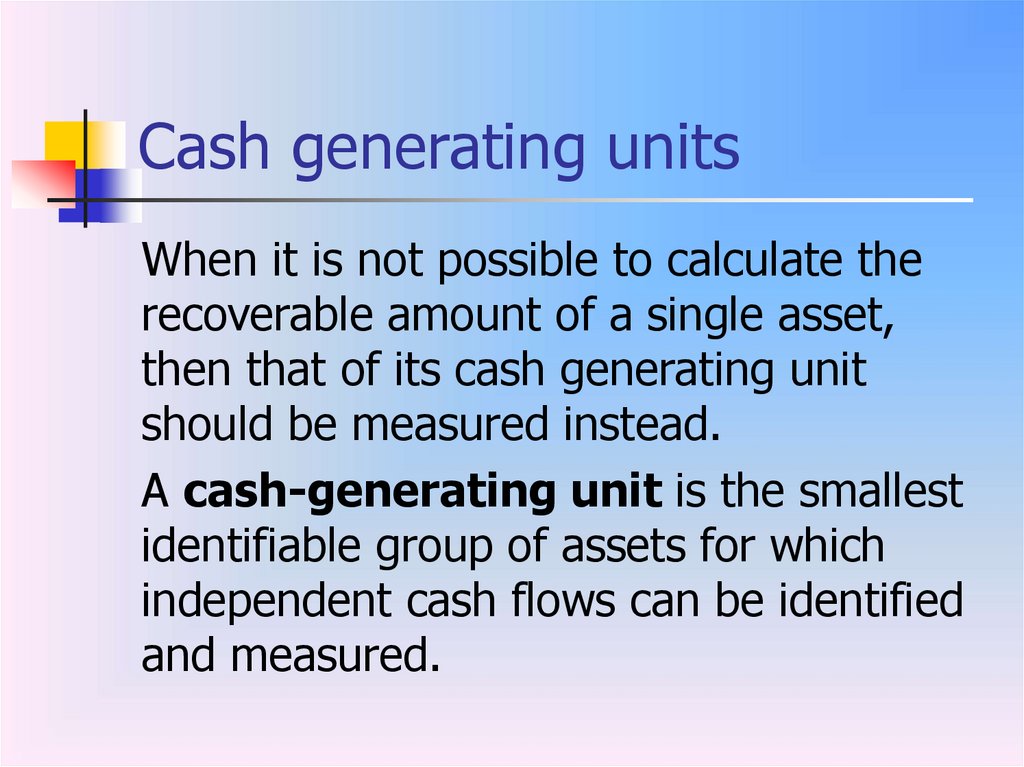
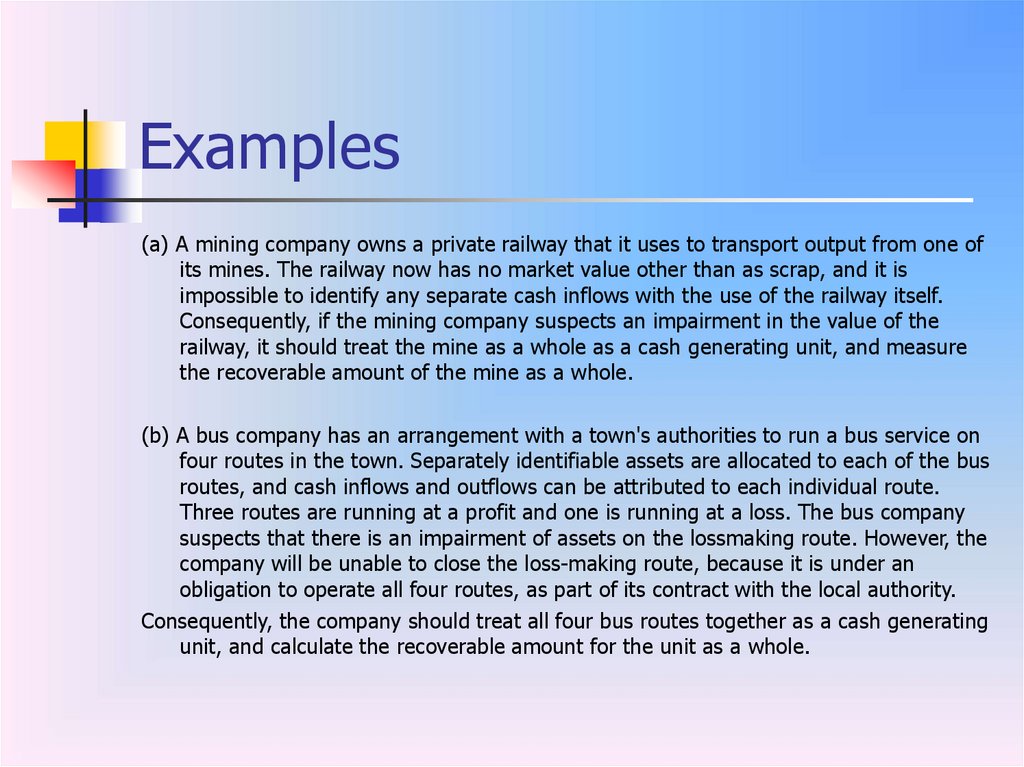
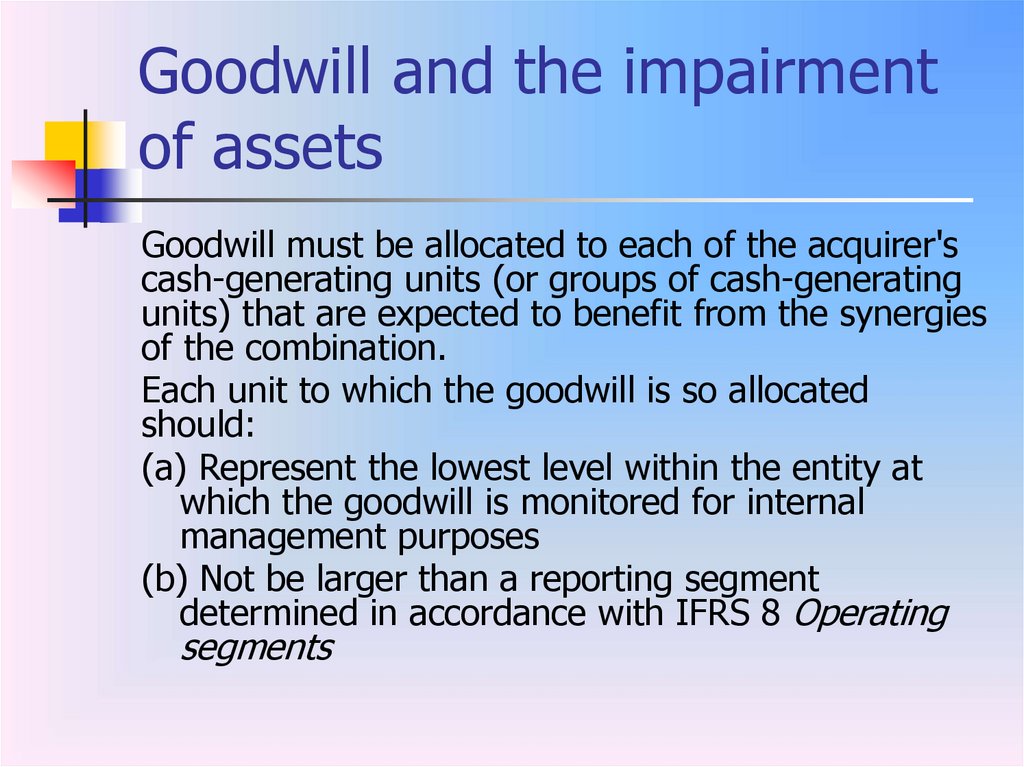





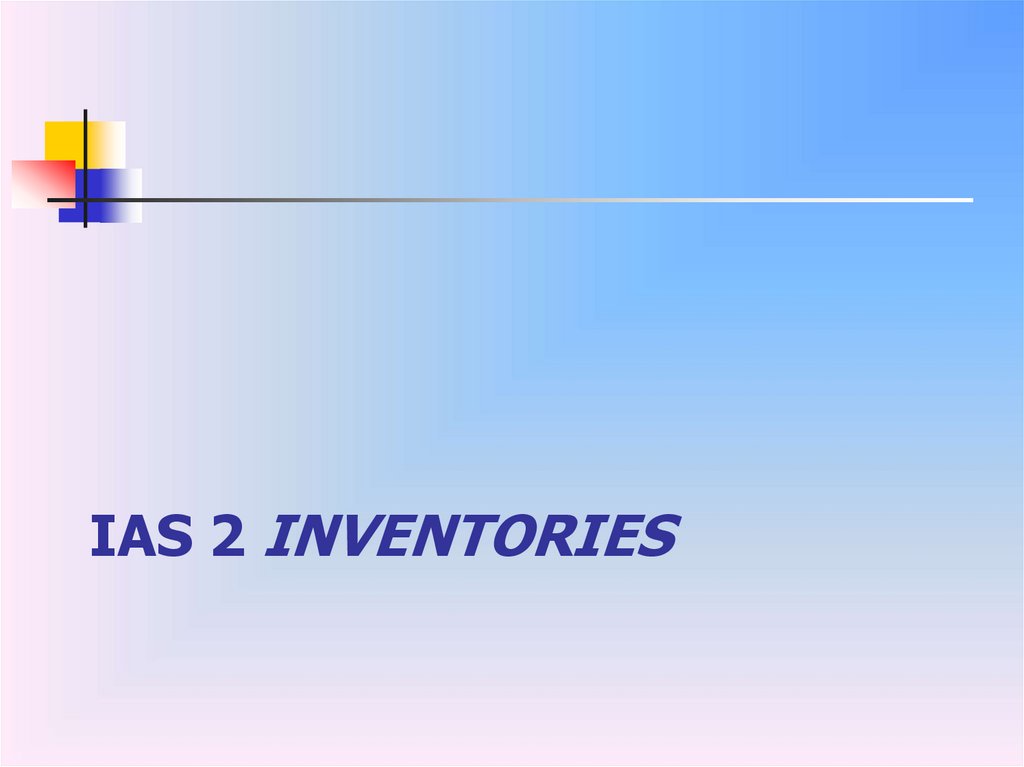


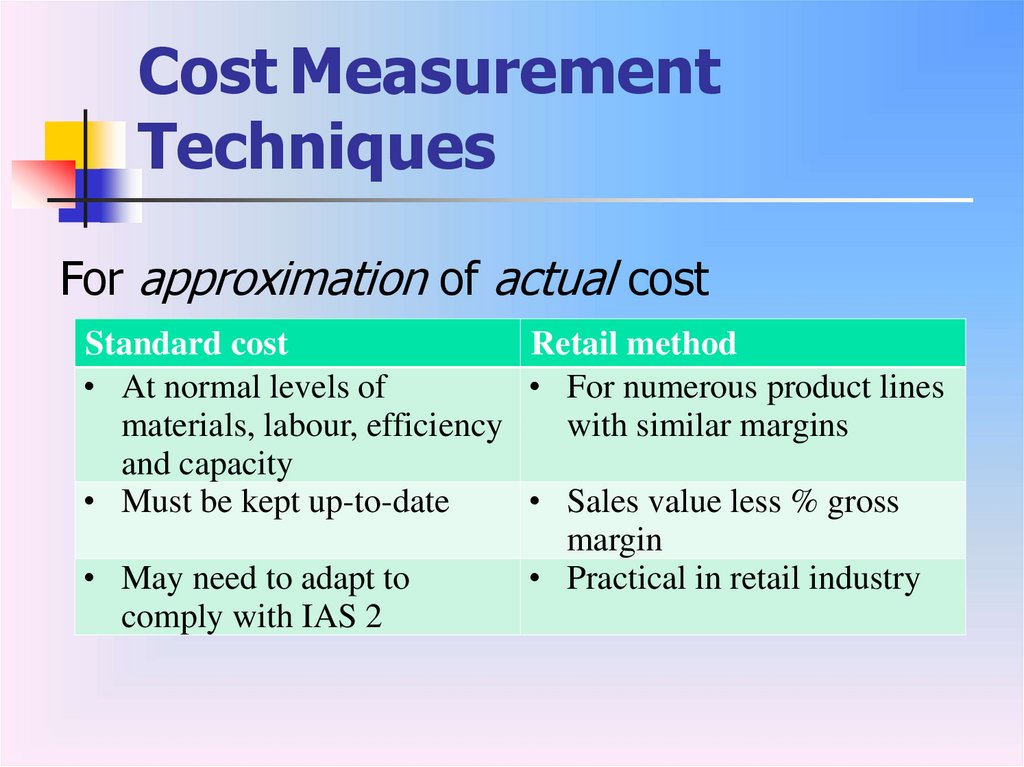
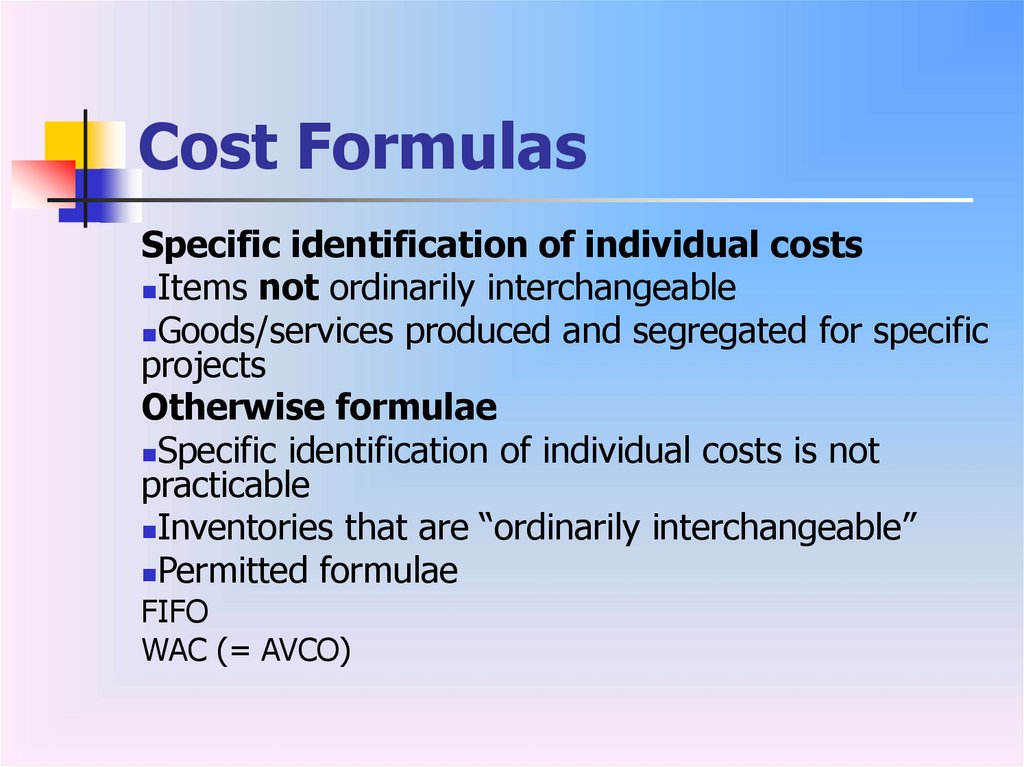

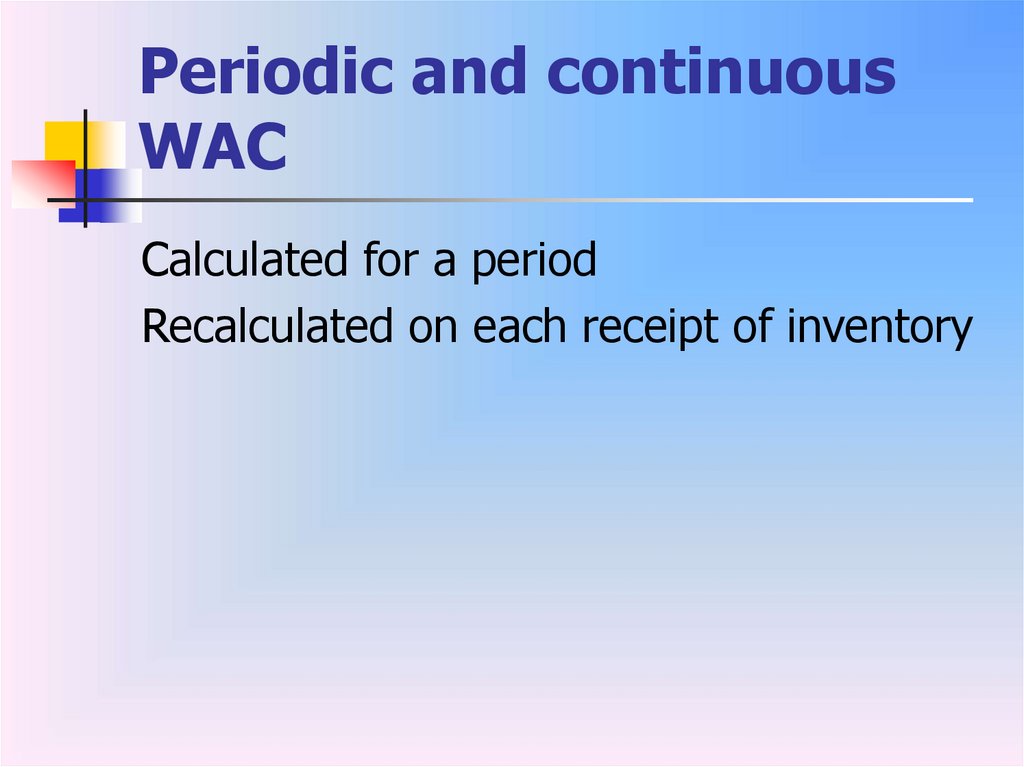
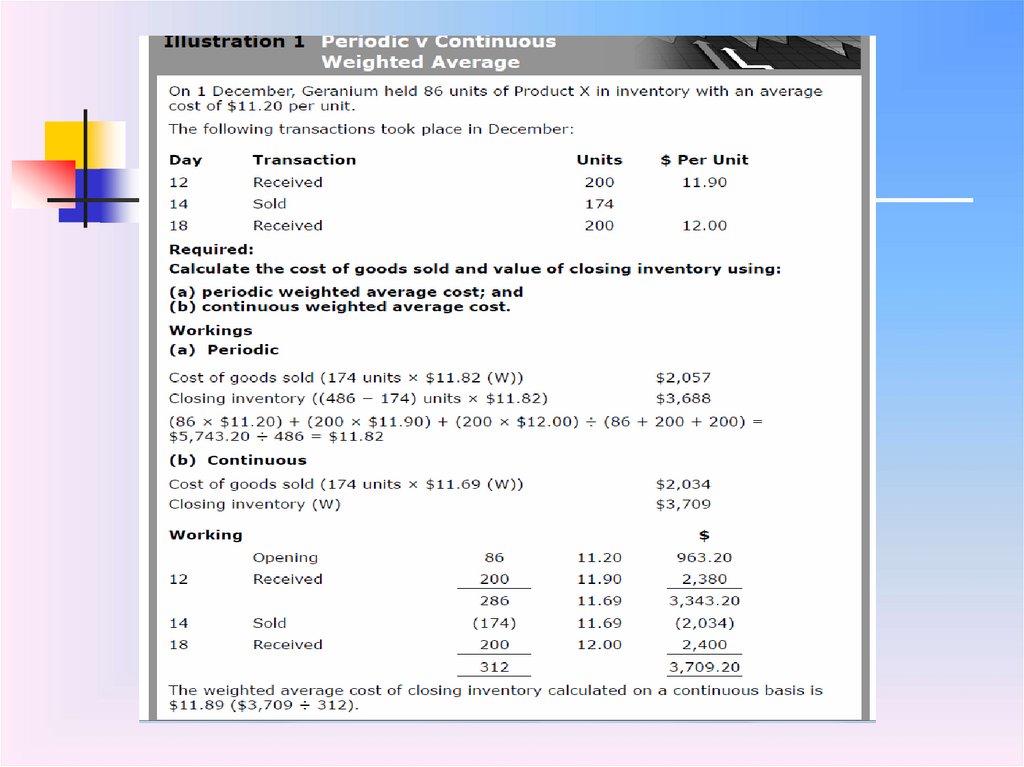
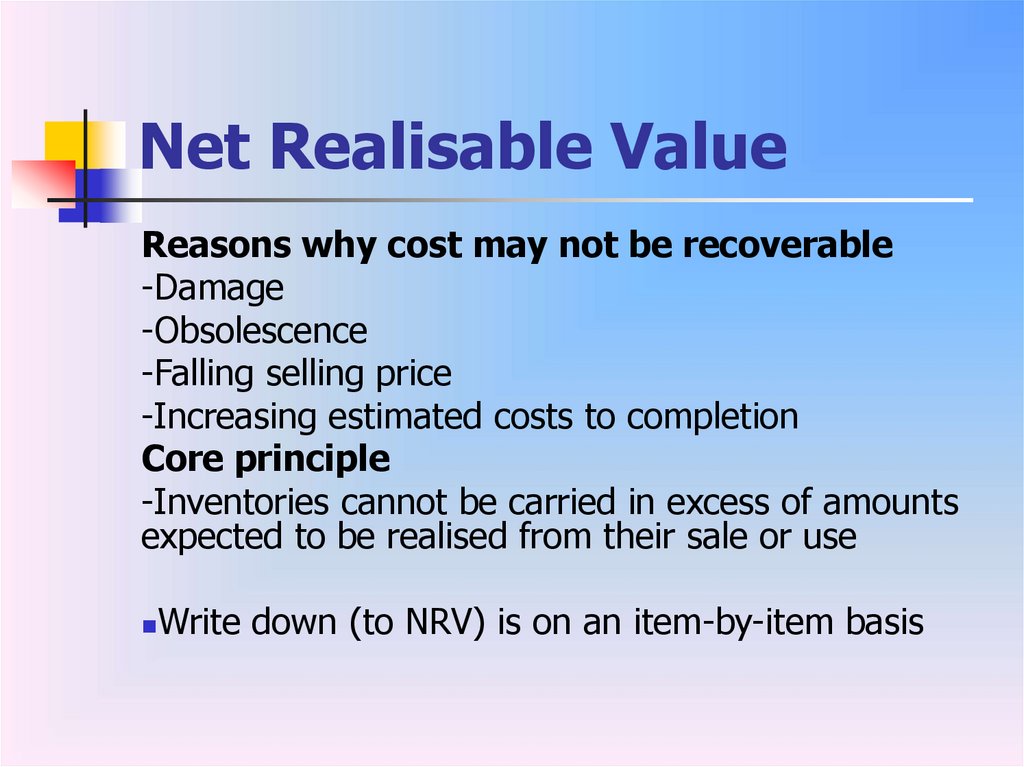

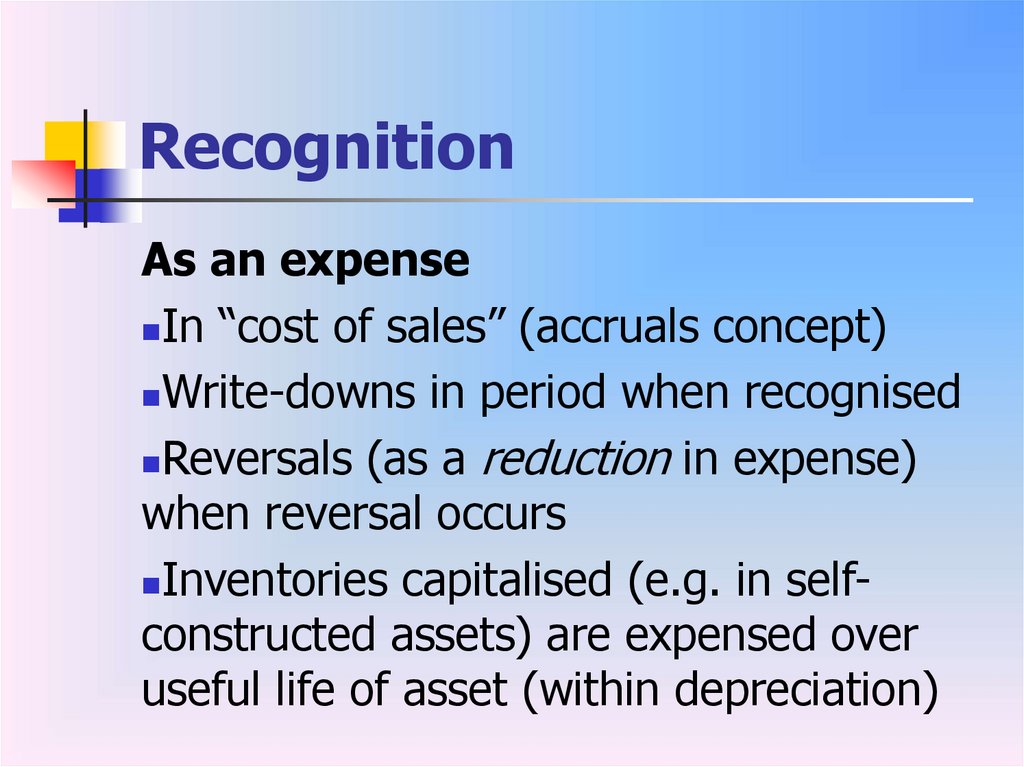
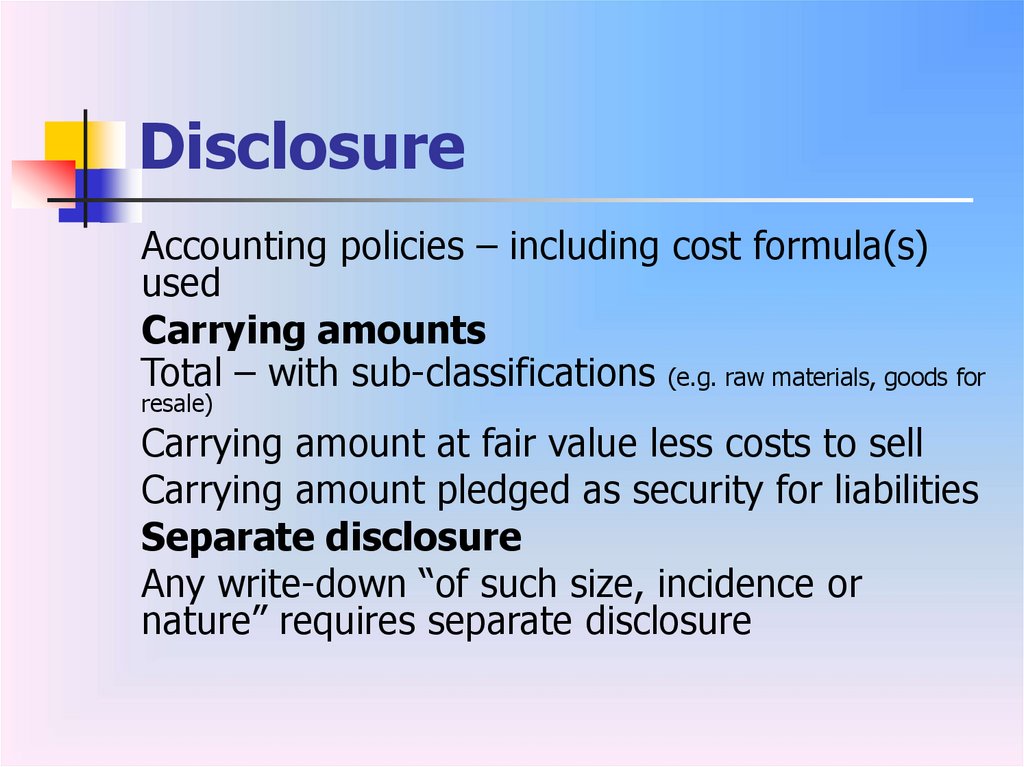
 Финансы
Финансы








